Strategic Management Plan for HSBC: Analysis and Application
VerifiedAdded on 2023/06/08
|24
|5618
|262
Report
AI Summary
This report provides a detailed analysis of HSBC's business strategy, examining the influence of the macro environment using the PESTEL framework, which considers political, economic, social, technological, environmental, and legal factors impacting the organization. It also assesses the internal environment and capabilities through frameworks like VRIO and McKinsey 7's model, evaluating HSBC's strengths, weaknesses, opportunities, and threats. The report applies Porter's Five Forces model to evaluate competitive forces and devises strategies to improve competitive edge and market position. Furthermore, it applies various theories, concepts, and models to produce a strategic management plan, critiquing and interpreting information to develop valid strategic directions and tactical actions for HSBC.
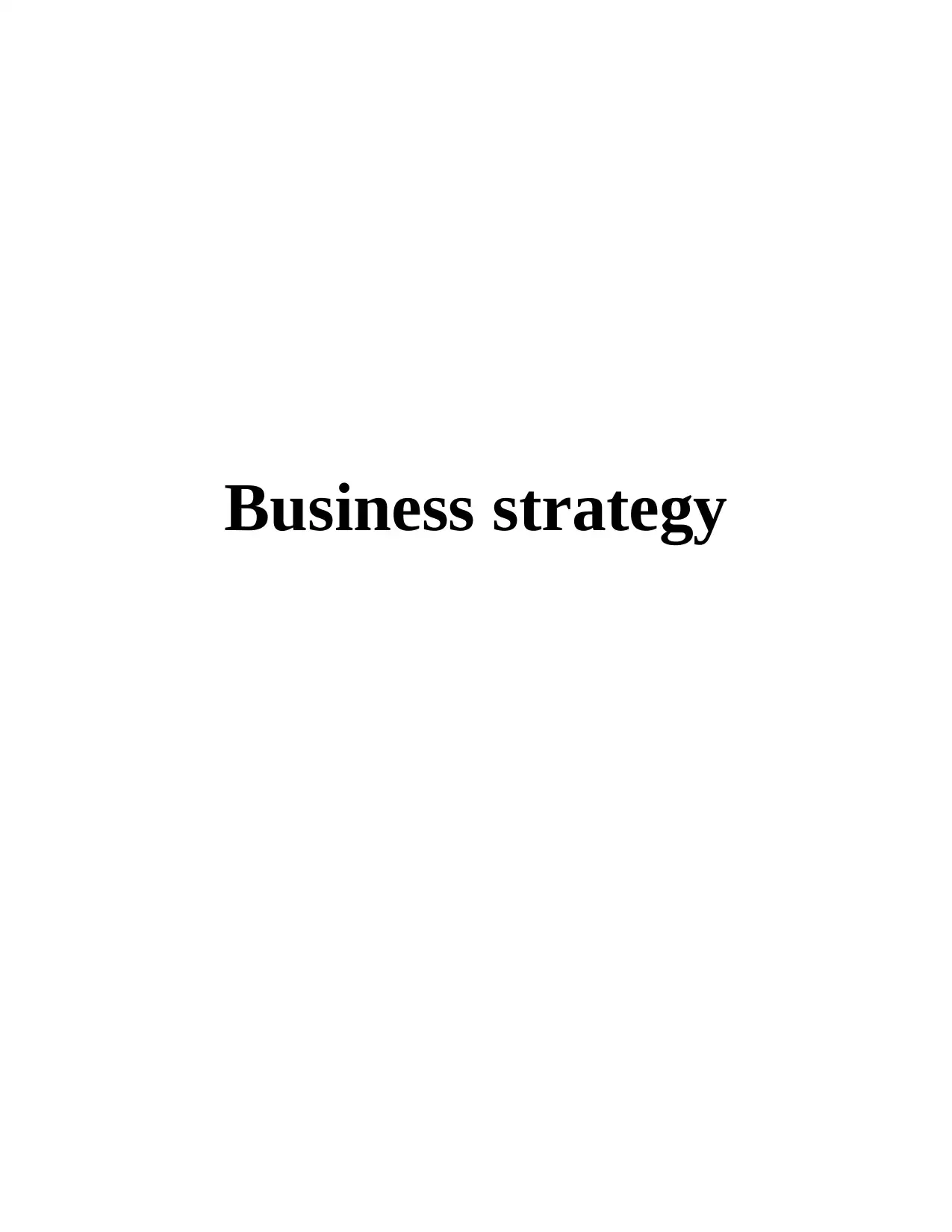
Business strategy
Paraphrase This Document
Need a fresh take? Get an instant paraphrase of this document with our AI Paraphraser
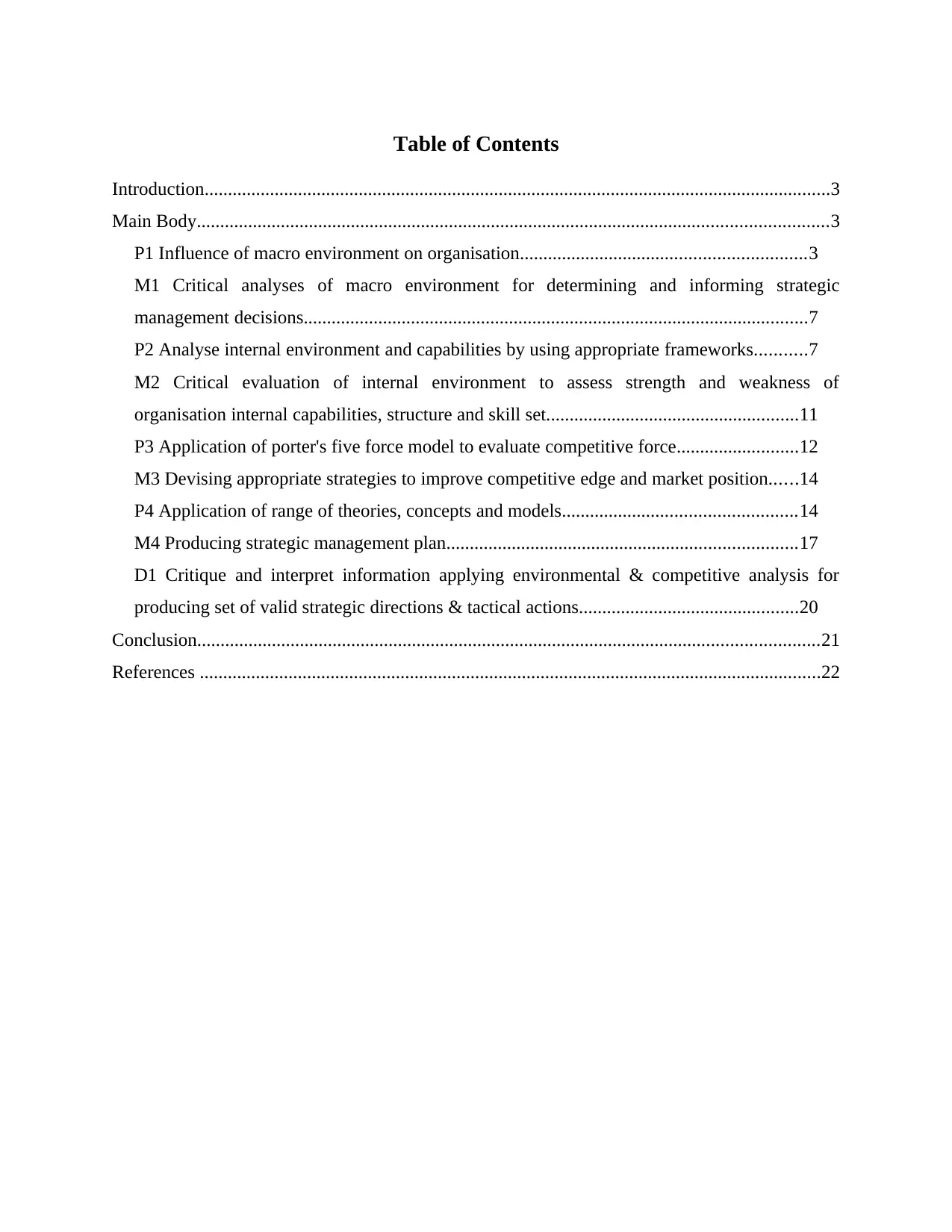
Table of Contents
Introduction......................................................................................................................................3
Main Body.......................................................................................................................................3
P1 Influence of macro environment on organisation.............................................................3
M1 Critical analyses of macro environment for determining and informing strategic
management decisions............................................................................................................7
P2 Analyse internal environment and capabilities by using appropriate frameworks...........7
M2 Critical evaluation of internal environment to assess strength and weakness of
organisation internal capabilities, structure and skill set......................................................11
P3 Application of porter's five force model to evaluate competitive force..........................12
M3 Devising appropriate strategies to improve competitive edge and market position......14
P4 Application of range of theories, concepts and models..................................................14
M4 Producing strategic management plan...........................................................................17
D1 Critique and interpret information applying environmental & competitive analysis for
producing set of valid strategic directions & tactical actions...............................................20
Conclusion.....................................................................................................................................21
References .....................................................................................................................................22
Introduction......................................................................................................................................3
Main Body.......................................................................................................................................3
P1 Influence of macro environment on organisation.............................................................3
M1 Critical analyses of macro environment for determining and informing strategic
management decisions............................................................................................................7
P2 Analyse internal environment and capabilities by using appropriate frameworks...........7
M2 Critical evaluation of internal environment to assess strength and weakness of
organisation internal capabilities, structure and skill set......................................................11
P3 Application of porter's five force model to evaluate competitive force..........................12
M3 Devising appropriate strategies to improve competitive edge and market position......14
P4 Application of range of theories, concepts and models..................................................14
M4 Producing strategic management plan...........................................................................17
D1 Critique and interpret information applying environmental & competitive analysis for
producing set of valid strategic directions & tactical actions...............................................20
Conclusion.....................................................................................................................................21
References .....................................................................................................................................22
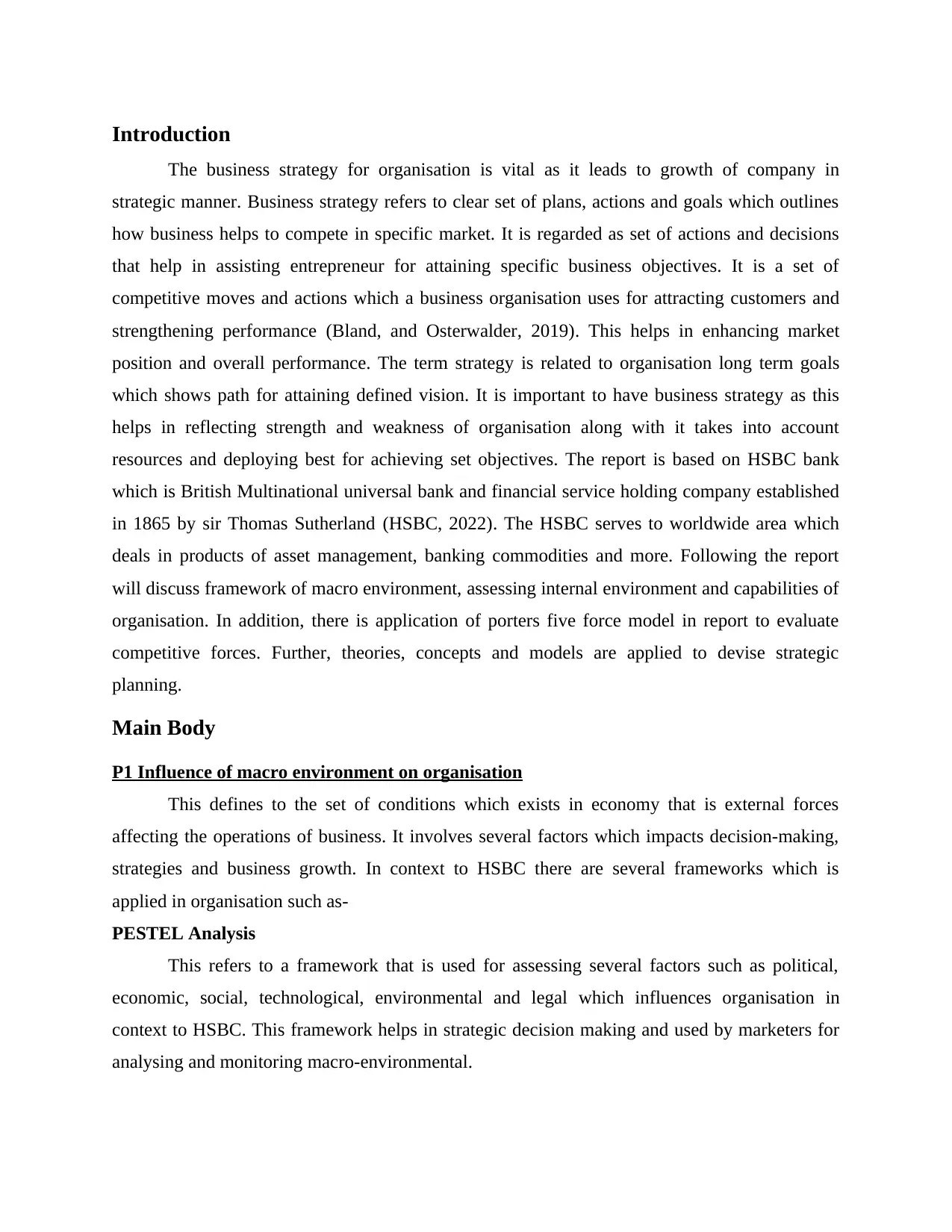
Introduction
The business strategy for organisation is vital as it leads to growth of company in
strategic manner. Business strategy refers to clear set of plans, actions and goals which outlines
how business helps to compete in specific market. It is regarded as set of actions and decisions
that help in assisting entrepreneur for attaining specific business objectives. It is a set of
competitive moves and actions which a business organisation uses for attracting customers and
strengthening performance (Bland, and Osterwalder, 2019). This helps in enhancing market
position and overall performance. The term strategy is related to organisation long term goals
which shows path for attaining defined vision. It is important to have business strategy as this
helps in reflecting strength and weakness of organisation along with it takes into account
resources and deploying best for achieving set objectives. The report is based on HSBC bank
which is British Multinational universal bank and financial service holding company established
in 1865 by sir Thomas Sutherland (HSBC, 2022). The HSBC serves to worldwide area which
deals in products of asset management, banking commodities and more. Following the report
will discuss framework of macro environment, assessing internal environment and capabilities of
organisation. In addition, there is application of porters five force model in report to evaluate
competitive forces. Further, theories, concepts and models are applied to devise strategic
planning.
Main Body
P1 Influence of macro environment on organisation
This defines to the set of conditions which exists in economy that is external forces
affecting the operations of business. It involves several factors which impacts decision-making,
strategies and business growth. In context to HSBC there are several frameworks which is
applied in organisation such as-
PESTEL Analysis
This refers to a framework that is used for assessing several factors such as political,
economic, social, technological, environmental and legal which influences organisation in
context to HSBC. This framework helps in strategic decision making and used by marketers for
analysing and monitoring macro-environmental.
The business strategy for organisation is vital as it leads to growth of company in
strategic manner. Business strategy refers to clear set of plans, actions and goals which outlines
how business helps to compete in specific market. It is regarded as set of actions and decisions
that help in assisting entrepreneur for attaining specific business objectives. It is a set of
competitive moves and actions which a business organisation uses for attracting customers and
strengthening performance (Bland, and Osterwalder, 2019). This helps in enhancing market
position and overall performance. The term strategy is related to organisation long term goals
which shows path for attaining defined vision. It is important to have business strategy as this
helps in reflecting strength and weakness of organisation along with it takes into account
resources and deploying best for achieving set objectives. The report is based on HSBC bank
which is British Multinational universal bank and financial service holding company established
in 1865 by sir Thomas Sutherland (HSBC, 2022). The HSBC serves to worldwide area which
deals in products of asset management, banking commodities and more. Following the report
will discuss framework of macro environment, assessing internal environment and capabilities of
organisation. In addition, there is application of porters five force model in report to evaluate
competitive forces. Further, theories, concepts and models are applied to devise strategic
planning.
Main Body
P1 Influence of macro environment on organisation
This defines to the set of conditions which exists in economy that is external forces
affecting the operations of business. It involves several factors which impacts decision-making,
strategies and business growth. In context to HSBC there are several frameworks which is
applied in organisation such as-
PESTEL Analysis
This refers to a framework that is used for assessing several factors such as political,
economic, social, technological, environmental and legal which influences organisation in
context to HSBC. This framework helps in strategic decision making and used by marketers for
analysing and monitoring macro-environmental.
⊘ This is a preview!⊘
Do you want full access?
Subscribe today to unlock all pages.

Trusted by 1+ million students worldwide
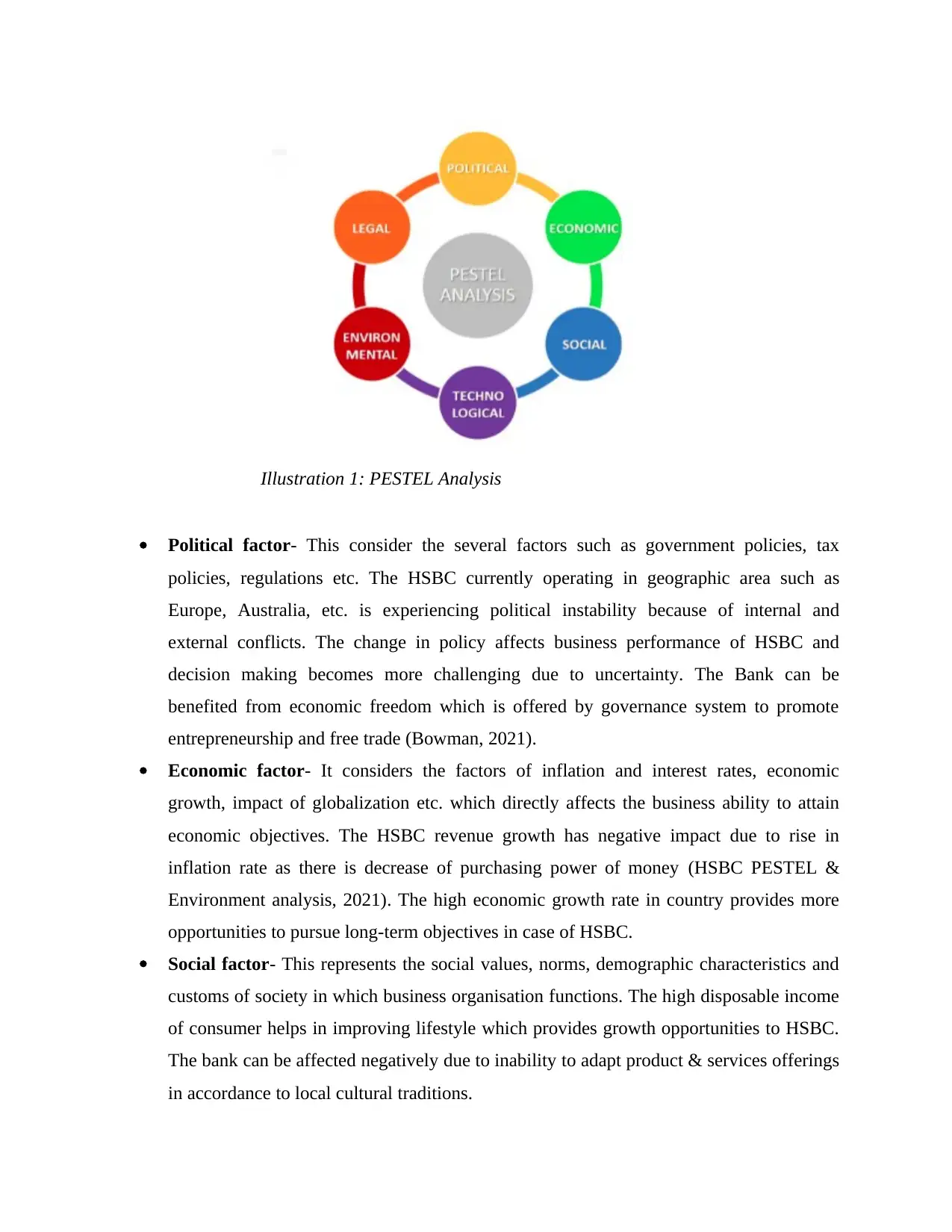
Political factor- This consider the several factors such as government policies, tax
policies, regulations etc. The HSBC currently operating in geographic area such as
Europe, Australia, etc. is experiencing political instability because of internal and
external conflicts. The change in policy affects business performance of HSBC and
decision making becomes more challenging due to uncertainty. The Bank can be
benefited from economic freedom which is offered by governance system to promote
entrepreneurship and free trade (Bowman, 2021).
Economic factor- It considers the factors of inflation and interest rates, economic
growth, impact of globalization etc. which directly affects the business ability to attain
economic objectives. The HSBC revenue growth has negative impact due to rise in
inflation rate as there is decrease of purchasing power of money (HSBC PESTEL &
Environment analysis, 2021). The high economic growth rate in country provides more
opportunities to pursue long-term objectives in case of HSBC.
Social factor- This represents the social values, norms, demographic characteristics and
customs of society in which business organisation functions. The high disposable income
of consumer helps in improving lifestyle which provides growth opportunities to HSBC.
The bank can be affected negatively due to inability to adapt product & services offerings
in accordance to local cultural traditions.
Illustration 1: PESTEL Analysis
policies, regulations etc. The HSBC currently operating in geographic area such as
Europe, Australia, etc. is experiencing political instability because of internal and
external conflicts. The change in policy affects business performance of HSBC and
decision making becomes more challenging due to uncertainty. The Bank can be
benefited from economic freedom which is offered by governance system to promote
entrepreneurship and free trade (Bowman, 2021).
Economic factor- It considers the factors of inflation and interest rates, economic
growth, impact of globalization etc. which directly affects the business ability to attain
economic objectives. The HSBC revenue growth has negative impact due to rise in
inflation rate as there is decrease of purchasing power of money (HSBC PESTEL &
Environment analysis, 2021). The high economic growth rate in country provides more
opportunities to pursue long-term objectives in case of HSBC.
Social factor- This represents the social values, norms, demographic characteristics and
customs of society in which business organisation functions. The high disposable income
of consumer helps in improving lifestyle which provides growth opportunities to HSBC.
The bank can be affected negatively due to inability to adapt product & services offerings
in accordance to local cultural traditions.
Illustration 1: PESTEL Analysis
Paraphrase This Document
Need a fresh take? Get an instant paraphrase of this document with our AI Paraphraser
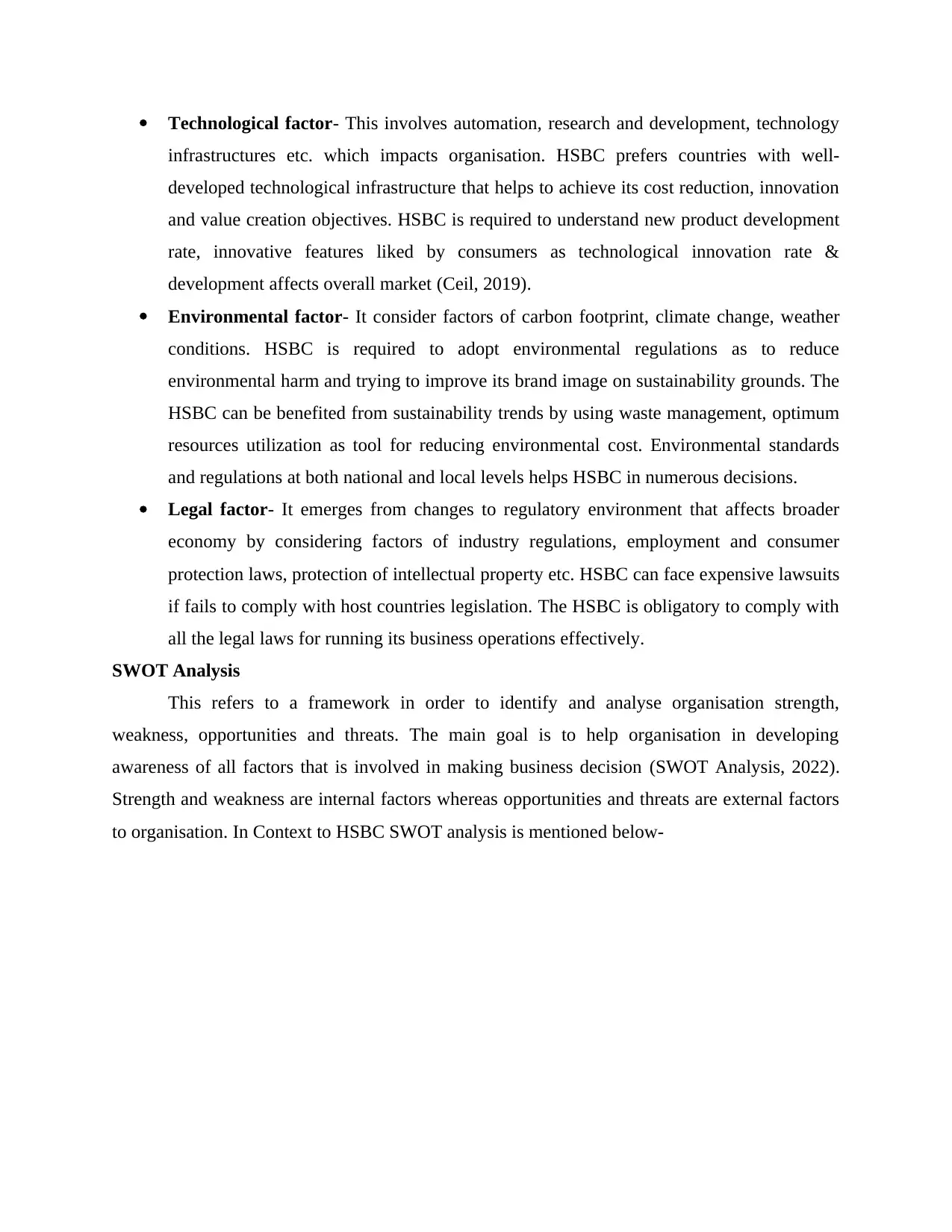
Technological factor- This involves automation, research and development, technology
infrastructures etc. which impacts organisation. HSBC prefers countries with well-
developed technological infrastructure that helps to achieve its cost reduction, innovation
and value creation objectives. HSBC is required to understand new product development
rate, innovative features liked by consumers as technological innovation rate &
development affects overall market (Ceil, 2019).
Environmental factor- It consider factors of carbon footprint, climate change, weather
conditions. HSBC is required to adopt environmental regulations as to reduce
environmental harm and trying to improve its brand image on sustainability grounds. The
HSBC can be benefited from sustainability trends by using waste management, optimum
resources utilization as tool for reducing environmental cost. Environmental standards
and regulations at both national and local levels helps HSBC in numerous decisions.
Legal factor- It emerges from changes to regulatory environment that affects broader
economy by considering factors of industry regulations, employment and consumer
protection laws, protection of intellectual property etc. HSBC can face expensive lawsuits
if fails to comply with host countries legislation. The HSBC is obligatory to comply with
all the legal laws for running its business operations effectively.
SWOT Analysis
This refers to a framework in order to identify and analyse organisation strength,
weakness, opportunities and threats. The main goal is to help organisation in developing
awareness of all factors that is involved in making business decision (SWOT Analysis, 2022).
Strength and weakness are internal factors whereas opportunities and threats are external factors
to organisation. In Context to HSBC SWOT analysis is mentioned below-
infrastructures etc. which impacts organisation. HSBC prefers countries with well-
developed technological infrastructure that helps to achieve its cost reduction, innovation
and value creation objectives. HSBC is required to understand new product development
rate, innovative features liked by consumers as technological innovation rate &
development affects overall market (Ceil, 2019).
Environmental factor- It consider factors of carbon footprint, climate change, weather
conditions. HSBC is required to adopt environmental regulations as to reduce
environmental harm and trying to improve its brand image on sustainability grounds. The
HSBC can be benefited from sustainability trends by using waste management, optimum
resources utilization as tool for reducing environmental cost. Environmental standards
and regulations at both national and local levels helps HSBC in numerous decisions.
Legal factor- It emerges from changes to regulatory environment that affects broader
economy by considering factors of industry regulations, employment and consumer
protection laws, protection of intellectual property etc. HSBC can face expensive lawsuits
if fails to comply with host countries legislation. The HSBC is obligatory to comply with
all the legal laws for running its business operations effectively.
SWOT Analysis
This refers to a framework in order to identify and analyse organisation strength,
weakness, opportunities and threats. The main goal is to help organisation in developing
awareness of all factors that is involved in making business decision (SWOT Analysis, 2022).
Strength and weakness are internal factors whereas opportunities and threats are external factors
to organisation. In Context to HSBC SWOT analysis is mentioned below-
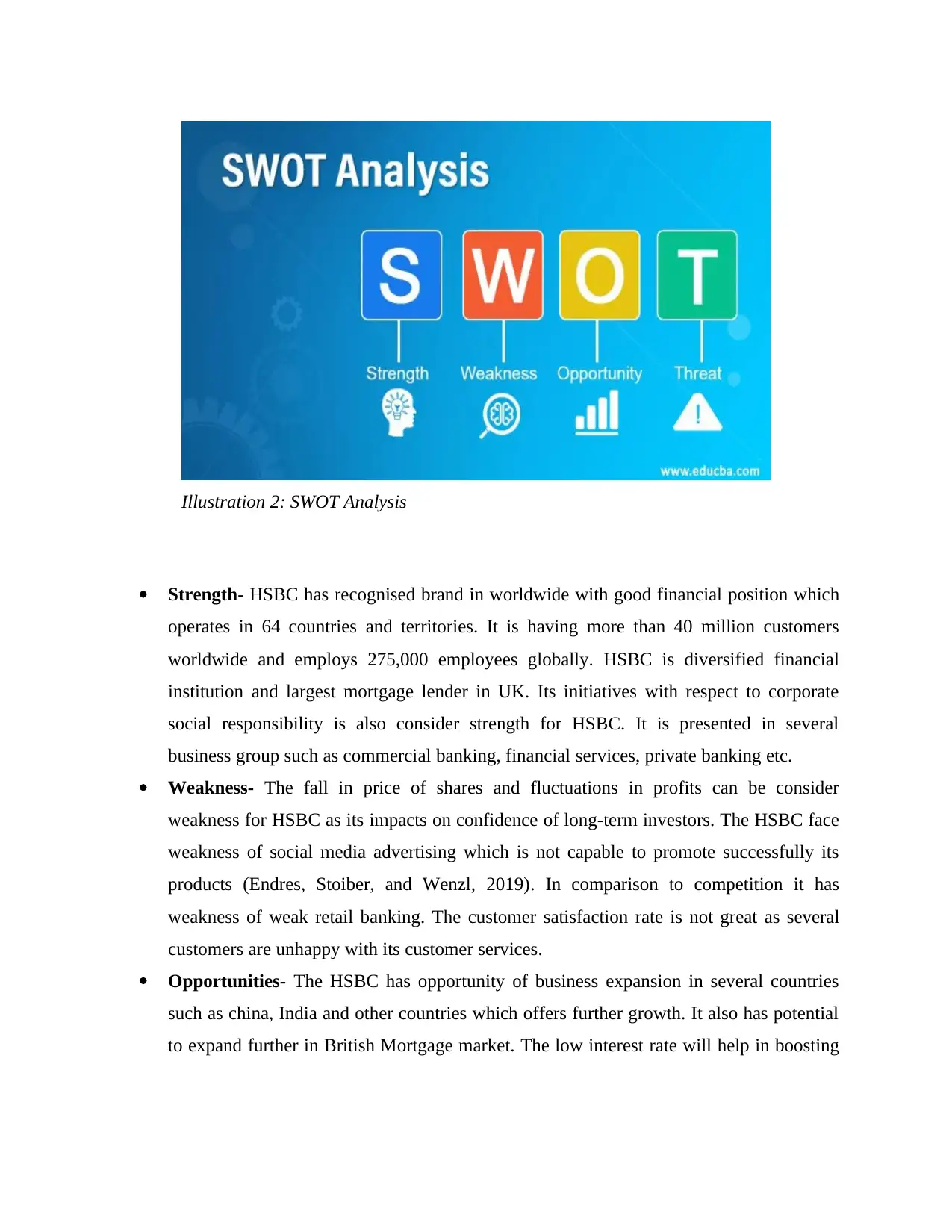
Strength- HSBC has recognised brand in worldwide with good financial position which
operates in 64 countries and territories. It is having more than 40 million customers
worldwide and employs 275,000 employees globally. HSBC is diversified financial
institution and largest mortgage lender in UK. Its initiatives with respect to corporate
social responsibility is also consider strength for HSBC. It is presented in several
business group such as commercial banking, financial services, private banking etc.
Weakness- The fall in price of shares and fluctuations in profits can be consider
weakness for HSBC as its impacts on confidence of long-term investors. The HSBC face
weakness of social media advertising which is not capable to promote successfully its
products (Endres, Stoiber, and Wenzl, 2019). In comparison to competition it has
weakness of weak retail banking. The customer satisfaction rate is not great as several
customers are unhappy with its customer services.
Opportunities- The HSBC has opportunity of business expansion in several countries
such as china, India and other countries which offers further growth. It also has potential
to expand further in British Mortgage market. The low interest rate will help in boosting
Illustration 2: SWOT Analysis
operates in 64 countries and territories. It is having more than 40 million customers
worldwide and employs 275,000 employees globally. HSBC is diversified financial
institution and largest mortgage lender in UK. Its initiatives with respect to corporate
social responsibility is also consider strength for HSBC. It is presented in several
business group such as commercial banking, financial services, private banking etc.
Weakness- The fall in price of shares and fluctuations in profits can be consider
weakness for HSBC as its impacts on confidence of long-term investors. The HSBC face
weakness of social media advertising which is not capable to promote successfully its
products (Endres, Stoiber, and Wenzl, 2019). In comparison to competition it has
weakness of weak retail banking. The customer satisfaction rate is not great as several
customers are unhappy with its customer services.
Opportunities- The HSBC has opportunity of business expansion in several countries
such as china, India and other countries which offers further growth. It also has potential
to expand further in British Mortgage market. The low interest rate will help in boosting
Illustration 2: SWOT Analysis
⊘ This is a preview!⊘
Do you want full access?
Subscribe today to unlock all pages.

Trusted by 1+ million students worldwide
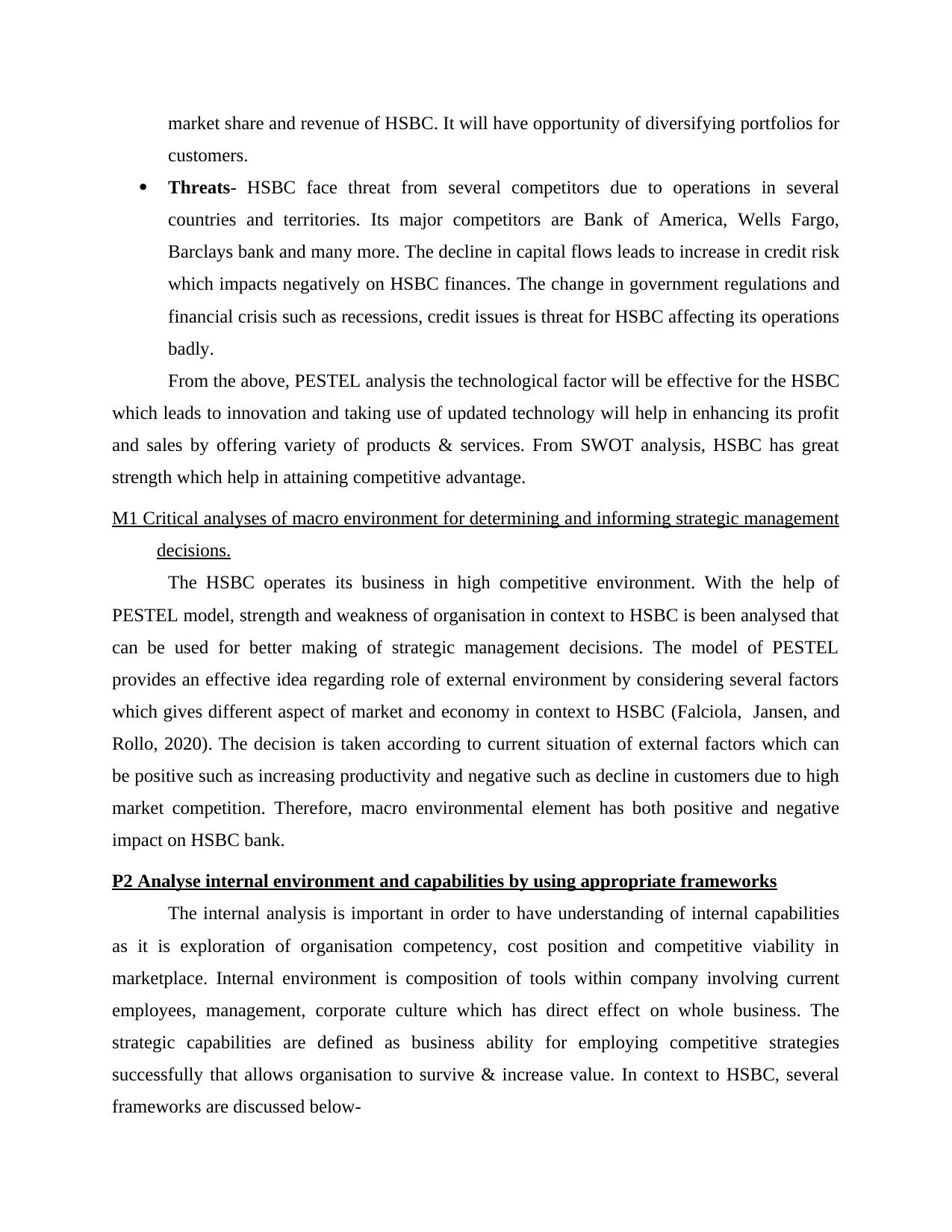
market share and revenue of HSBC. It will have opportunity of diversifying portfolios for
customers.
Threats- HSBC face threat from several competitors due to operations in several
countries and territories. Its major competitors are Bank of America, Wells Fargo,
Barclays bank and many more. The decline in capital flows leads to increase in credit risk
which impacts negatively on HSBC finances. The change in government regulations and
financial crisis such as recessions, credit issues is threat for HSBC affecting its operations
badly.
From the above, PESTEL analysis the technological factor will be effective for the HSBC
which leads to innovation and taking use of updated technology will help in enhancing its profit
and sales by offering variety of products & services. From SWOT analysis, HSBC has great
strength which help in attaining competitive advantage.
M1 Critical analyses of macro environment for determining and informing strategic management
decisions.
The HSBC operates its business in high competitive environment. With the help of
PESTEL model, strength and weakness of organisation in context to HSBC is been analysed that
can be used for better making of strategic management decisions. The model of PESTEL
provides an effective idea regarding role of external environment by considering several factors
which gives different aspect of market and economy in context to HSBC (Falciola, Jansen, and
Rollo, 2020). The decision is taken according to current situation of external factors which can
be positive such as increasing productivity and negative such as decline in customers due to high
market competition. Therefore, macro environmental element has both positive and negative
impact on HSBC bank.
P2 Analyse internal environment and capabilities by using appropriate frameworks
The internal analysis is important in order to have understanding of internal capabilities
as it is exploration of organisation competency, cost position and competitive viability in
marketplace. Internal environment is composition of tools within company involving current
employees, management, corporate culture which has direct effect on whole business. The
strategic capabilities are defined as business ability for employing competitive strategies
successfully that allows organisation to survive & increase value. In context to HSBC, several
frameworks are discussed below-
customers.
Threats- HSBC face threat from several competitors due to operations in several
countries and territories. Its major competitors are Bank of America, Wells Fargo,
Barclays bank and many more. The decline in capital flows leads to increase in credit risk
which impacts negatively on HSBC finances. The change in government regulations and
financial crisis such as recessions, credit issues is threat for HSBC affecting its operations
badly.
From the above, PESTEL analysis the technological factor will be effective for the HSBC
which leads to innovation and taking use of updated technology will help in enhancing its profit
and sales by offering variety of products & services. From SWOT analysis, HSBC has great
strength which help in attaining competitive advantage.
M1 Critical analyses of macro environment for determining and informing strategic management
decisions.
The HSBC operates its business in high competitive environment. With the help of
PESTEL model, strength and weakness of organisation in context to HSBC is been analysed that
can be used for better making of strategic management decisions. The model of PESTEL
provides an effective idea regarding role of external environment by considering several factors
which gives different aspect of market and economy in context to HSBC (Falciola, Jansen, and
Rollo, 2020). The decision is taken according to current situation of external factors which can
be positive such as increasing productivity and negative such as decline in customers due to high
market competition. Therefore, macro environmental element has both positive and negative
impact on HSBC bank.
P2 Analyse internal environment and capabilities by using appropriate frameworks
The internal analysis is important in order to have understanding of internal capabilities
as it is exploration of organisation competency, cost position and competitive viability in
marketplace. Internal environment is composition of tools within company involving current
employees, management, corporate culture which has direct effect on whole business. The
strategic capabilities are defined as business ability for employing competitive strategies
successfully that allows organisation to survive & increase value. In context to HSBC, several
frameworks are discussed below-
Paraphrase This Document
Need a fresh take? Get an instant paraphrase of this document with our AI Paraphraser
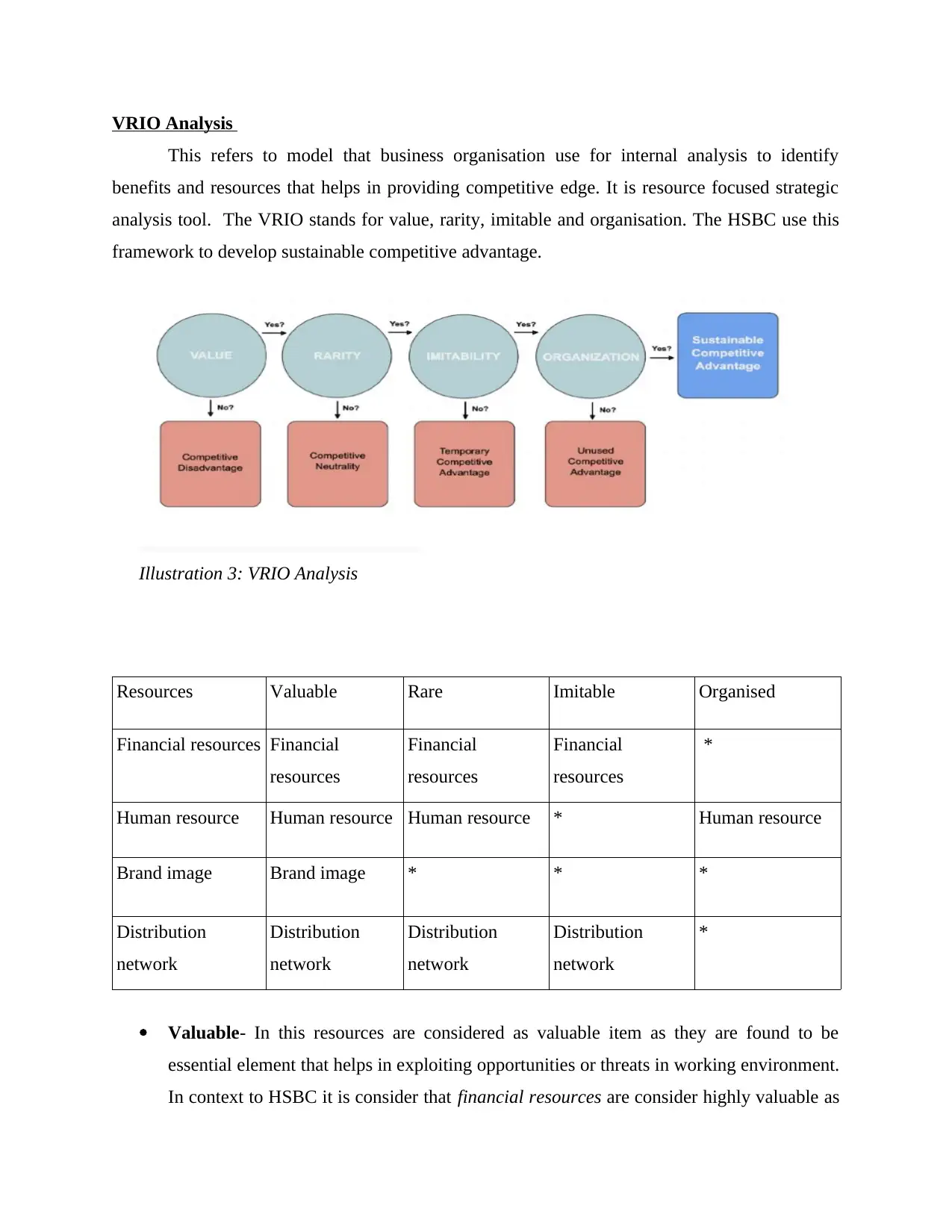
VRIO Analysis
This refers to model that business organisation use for internal analysis to identify
benefits and resources that helps in providing competitive edge. It is resource focused strategic
analysis tool. The VRIO stands for value, rarity, imitable and organisation. The HSBC use this
framework to develop sustainable competitive advantage.
Resources Valuable Rare Imitable Organised
Financial resources Financial
resources
Financial
resources
Financial
resources
*
Human resource Human resource Human resource * Human resource
Brand image Brand image * * *
Distribution
network
Distribution
network
Distribution
network
Distribution
network
*
Valuable- In this resources are considered as valuable item as they are found to be
essential element that helps in exploiting opportunities or threats in working environment.
In context to HSBC it is consider that financial resources are consider highly valuable as
Illustration 3: VRIO Analysis
This refers to model that business organisation use for internal analysis to identify
benefits and resources that helps in providing competitive edge. It is resource focused strategic
analysis tool. The VRIO stands for value, rarity, imitable and organisation. The HSBC use this
framework to develop sustainable competitive advantage.
Resources Valuable Rare Imitable Organised
Financial resources Financial
resources
Financial
resources
Financial
resources
*
Human resource Human resource Human resource * Human resource
Brand image Brand image * * *
Distribution
network
Distribution
network
Distribution
network
Distribution
network
*
Valuable- In this resources are considered as valuable item as they are found to be
essential element that helps in exploiting opportunities or threats in working environment.
In context to HSBC it is consider that financial resources are consider highly valuable as
Illustration 3: VRIO Analysis
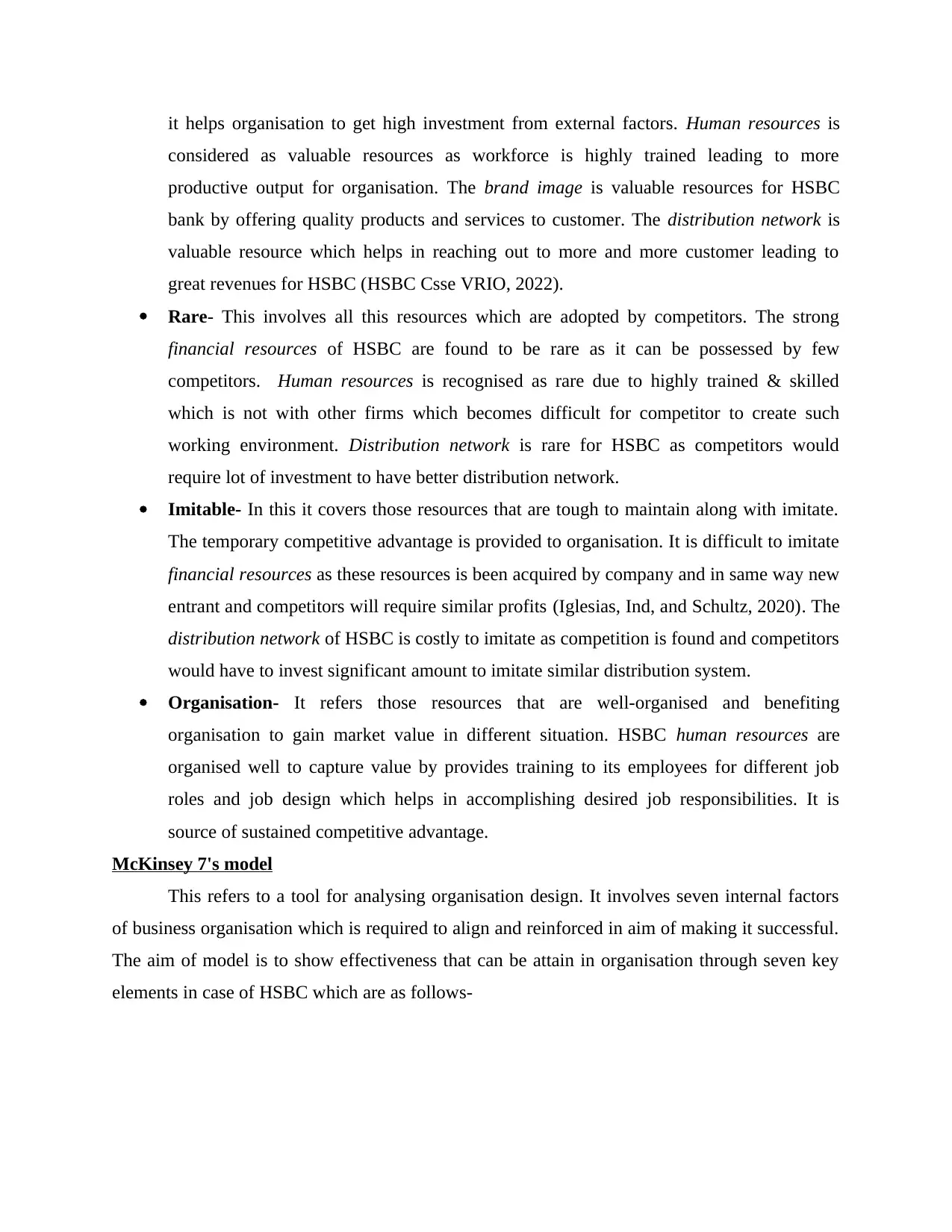
it helps organisation to get high investment from external factors. Human resources is
considered as valuable resources as workforce is highly trained leading to more
productive output for organisation. The brand image is valuable resources for HSBC
bank by offering quality products and services to customer. The distribution network is
valuable resource which helps in reaching out to more and more customer leading to
great revenues for HSBC (HSBC Csse VRIO, 2022).
Rare- This involves all this resources which are adopted by competitors. The strong
financial resources of HSBC are found to be rare as it can be possessed by few
competitors. Human resources is recognised as rare due to highly trained & skilled
which is not with other firms which becomes difficult for competitor to create such
working environment. Distribution network is rare for HSBC as competitors would
require lot of investment to have better distribution network.
Imitable- In this it covers those resources that are tough to maintain along with imitate.
The temporary competitive advantage is provided to organisation. It is difficult to imitate
financial resources as these resources is been acquired by company and in same way new
entrant and competitors will require similar profits (Iglesias, Ind, and Schultz, 2020). The
distribution network of HSBC is costly to imitate as competition is found and competitors
would have to invest significant amount to imitate similar distribution system.
Organisation- It refers those resources that are well-organised and benefiting
organisation to gain market value in different situation. HSBC human resources are
organised well to capture value by provides training to its employees for different job
roles and job design which helps in accomplishing desired job responsibilities. It is
source of sustained competitive advantage.
McKinsey 7's model
This refers to a tool for analysing organisation design. It involves seven internal factors
of business organisation which is required to align and reinforced in aim of making it successful.
The aim of model is to show effectiveness that can be attain in organisation through seven key
elements in case of HSBC which are as follows-
considered as valuable resources as workforce is highly trained leading to more
productive output for organisation. The brand image is valuable resources for HSBC
bank by offering quality products and services to customer. The distribution network is
valuable resource which helps in reaching out to more and more customer leading to
great revenues for HSBC (HSBC Csse VRIO, 2022).
Rare- This involves all this resources which are adopted by competitors. The strong
financial resources of HSBC are found to be rare as it can be possessed by few
competitors. Human resources is recognised as rare due to highly trained & skilled
which is not with other firms which becomes difficult for competitor to create such
working environment. Distribution network is rare for HSBC as competitors would
require lot of investment to have better distribution network.
Imitable- In this it covers those resources that are tough to maintain along with imitate.
The temporary competitive advantage is provided to organisation. It is difficult to imitate
financial resources as these resources is been acquired by company and in same way new
entrant and competitors will require similar profits (Iglesias, Ind, and Schultz, 2020). The
distribution network of HSBC is costly to imitate as competition is found and competitors
would have to invest significant amount to imitate similar distribution system.
Organisation- It refers those resources that are well-organised and benefiting
organisation to gain market value in different situation. HSBC human resources are
organised well to capture value by provides training to its employees for different job
roles and job design which helps in accomplishing desired job responsibilities. It is
source of sustained competitive advantage.
McKinsey 7's model
This refers to a tool for analysing organisation design. It involves seven internal factors
of business organisation which is required to align and reinforced in aim of making it successful.
The aim of model is to show effectiveness that can be attain in organisation through seven key
elements in case of HSBC which are as follows-
⊘ This is a preview!⊘
Do you want full access?
Subscribe today to unlock all pages.

Trusted by 1+ million students worldwide
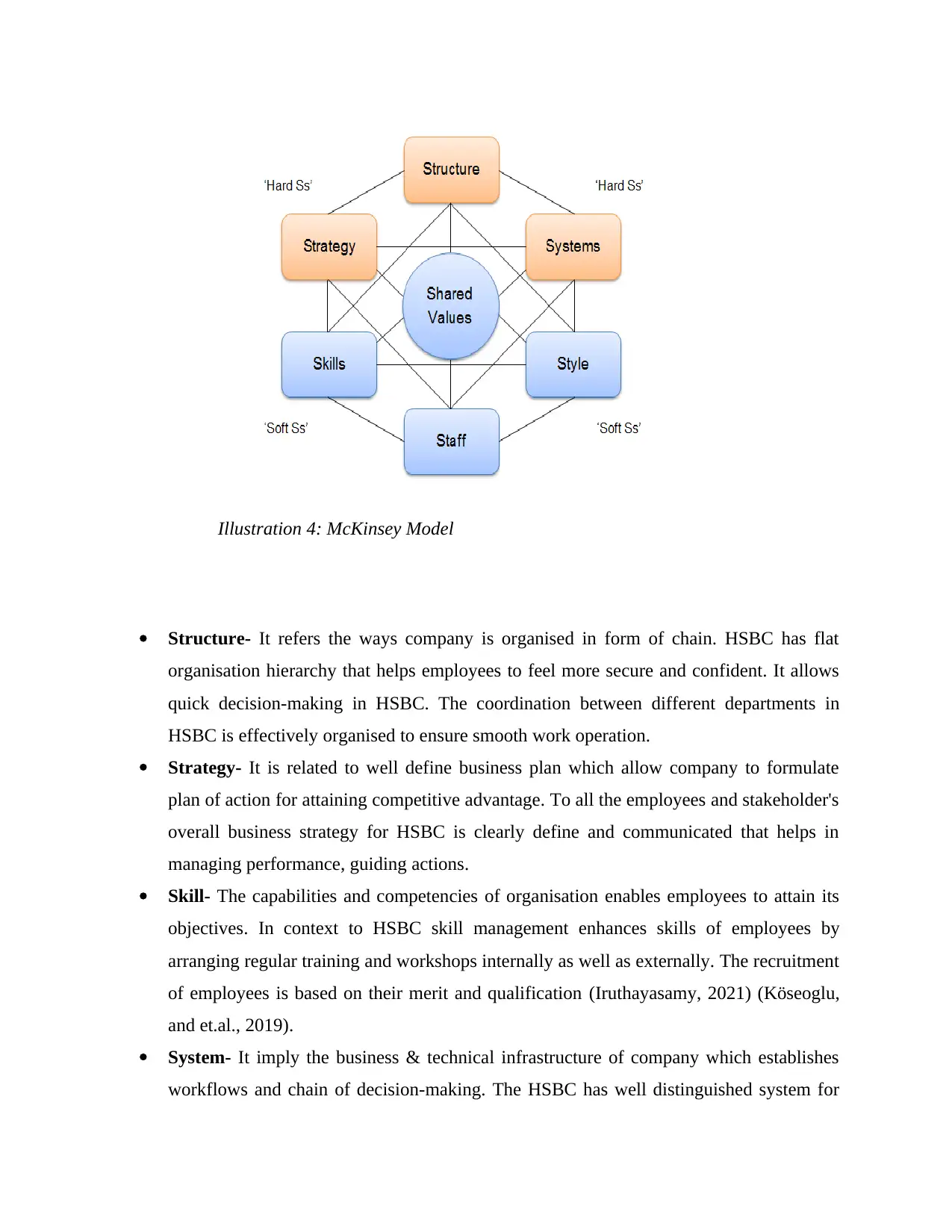
Structure- It refers the ways company is organised in form of chain. HSBC has flat
organisation hierarchy that helps employees to feel more secure and confident. It allows
quick decision-making in HSBC. The coordination between different departments in
HSBC is effectively organised to ensure smooth work operation.
Strategy- It is related to well define business plan which allow company to formulate
plan of action for attaining competitive advantage. To all the employees and stakeholder's
overall business strategy for HSBC is clearly define and communicated that helps in
managing performance, guiding actions.
Skill- The capabilities and competencies of organisation enables employees to attain its
objectives. In context to HSBC skill management enhances skills of employees by
arranging regular training and workshops internally as well as externally. The recruitment
of employees is based on their merit and qualification (Iruthayasamy, 2021) (Köseoglu,
and et.al., 2019).
System- It imply the business & technical infrastructure of company which establishes
workflows and chain of decision-making. The HSBC has well distinguished system for
Illustration 4: McKinsey Model
organisation hierarchy that helps employees to feel more secure and confident. It allows
quick decision-making in HSBC. The coordination between different departments in
HSBC is effectively organised to ensure smooth work operation.
Strategy- It is related to well define business plan which allow company to formulate
plan of action for attaining competitive advantage. To all the employees and stakeholder's
overall business strategy for HSBC is clearly define and communicated that helps in
managing performance, guiding actions.
Skill- The capabilities and competencies of organisation enables employees to attain its
objectives. In context to HSBC skill management enhances skills of employees by
arranging regular training and workshops internally as well as externally. The recruitment
of employees is based on their merit and qualification (Iruthayasamy, 2021) (Köseoglu,
and et.al., 2019).
System- It imply the business & technical infrastructure of company which establishes
workflows and chain of decision-making. The HSBC has well distinguished system for
Illustration 4: McKinsey Model
Paraphrase This Document
Need a fresh take? Get an instant paraphrase of this document with our AI Paraphraser
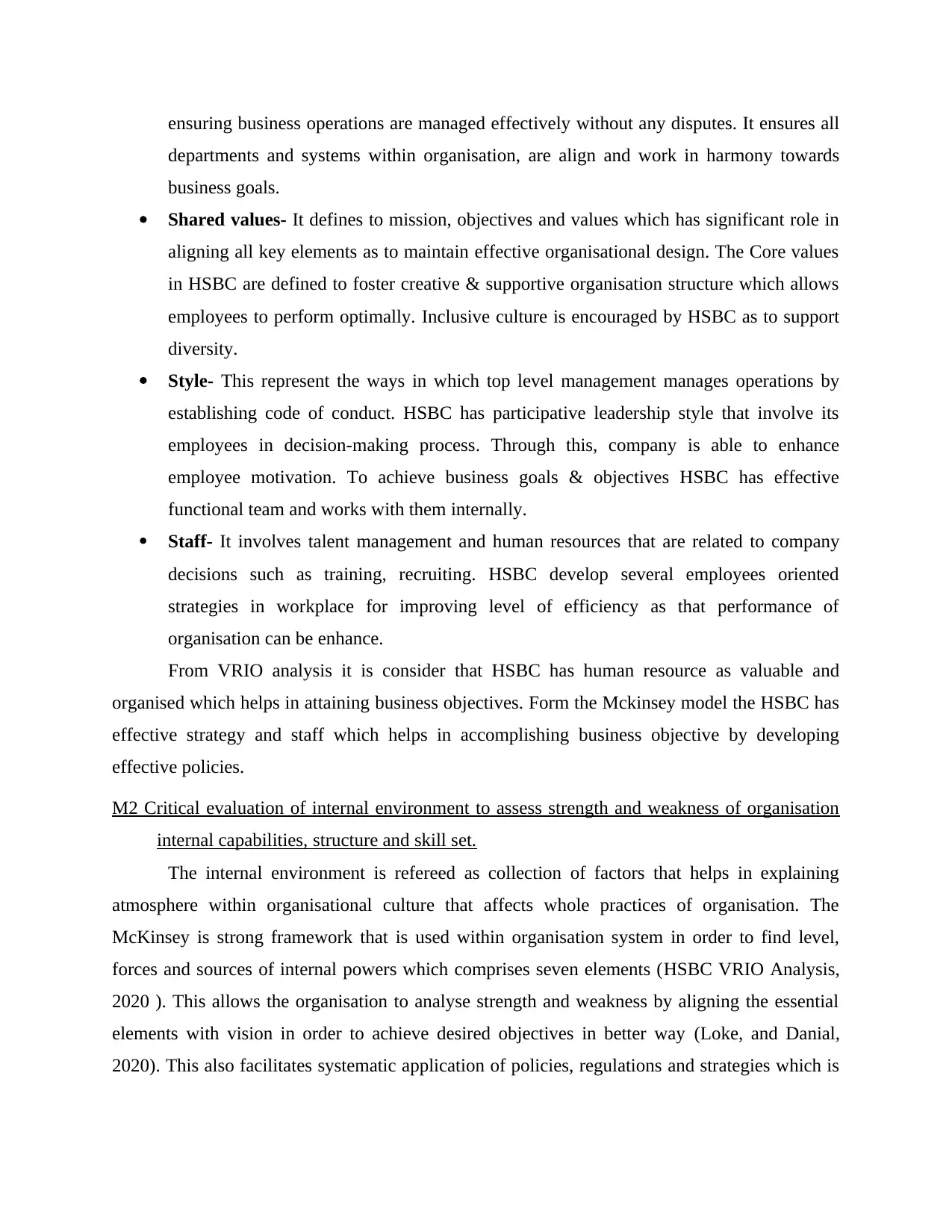
ensuring business operations are managed effectively without any disputes. It ensures all
departments and systems within organisation, are align and work in harmony towards
business goals.
Shared values- It defines to mission, objectives and values which has significant role in
aligning all key elements as to maintain effective organisational design. The Core values
in HSBC are defined to foster creative & supportive organisation structure which allows
employees to perform optimally. Inclusive culture is encouraged by HSBC as to support
diversity.
Style- This represent the ways in which top level management manages operations by
establishing code of conduct. HSBC has participative leadership style that involve its
employees in decision-making process. Through this, company is able to enhance
employee motivation. To achieve business goals & objectives HSBC has effective
functional team and works with them internally.
Staff- It involves talent management and human resources that are related to company
decisions such as training, recruiting. HSBC develop several employees oriented
strategies in workplace for improving level of efficiency as that performance of
organisation can be enhance.
From VRIO analysis it is consider that HSBC has human resource as valuable and
organised which helps in attaining business objectives. Form the Mckinsey model the HSBC has
effective strategy and staff which helps in accomplishing business objective by developing
effective policies.
M2 Critical evaluation of internal environment to assess strength and weakness of organisation
internal capabilities, structure and skill set.
The internal environment is refereed as collection of factors that helps in explaining
atmosphere within organisational culture that affects whole practices of organisation. The
McKinsey is strong framework that is used within organisation system in order to find level,
forces and sources of internal powers which comprises seven elements (HSBC VRIO Analysis,
2020 ). This allows the organisation to analyse strength and weakness by aligning the essential
elements with vision in order to achieve desired objectives in better way (Loke, and Danial,
2020). This also facilitates systematic application of policies, regulations and strategies which is
departments and systems within organisation, are align and work in harmony towards
business goals.
Shared values- It defines to mission, objectives and values which has significant role in
aligning all key elements as to maintain effective organisational design. The Core values
in HSBC are defined to foster creative & supportive organisation structure which allows
employees to perform optimally. Inclusive culture is encouraged by HSBC as to support
diversity.
Style- This represent the ways in which top level management manages operations by
establishing code of conduct. HSBC has participative leadership style that involve its
employees in decision-making process. Through this, company is able to enhance
employee motivation. To achieve business goals & objectives HSBC has effective
functional team and works with them internally.
Staff- It involves talent management and human resources that are related to company
decisions such as training, recruiting. HSBC develop several employees oriented
strategies in workplace for improving level of efficiency as that performance of
organisation can be enhance.
From VRIO analysis it is consider that HSBC has human resource as valuable and
organised which helps in attaining business objectives. Form the Mckinsey model the HSBC has
effective strategy and staff which helps in accomplishing business objective by developing
effective policies.
M2 Critical evaluation of internal environment to assess strength and weakness of organisation
internal capabilities, structure and skill set.
The internal environment is refereed as collection of factors that helps in explaining
atmosphere within organisational culture that affects whole practices of organisation. The
McKinsey is strong framework that is used within organisation system in order to find level,
forces and sources of internal powers which comprises seven elements (HSBC VRIO Analysis,
2020 ). This allows the organisation to analyse strength and weakness by aligning the essential
elements with vision in order to achieve desired objectives in better way (Loke, and Danial,
2020). This also facilitates systematic application of policies, regulations and strategies which is
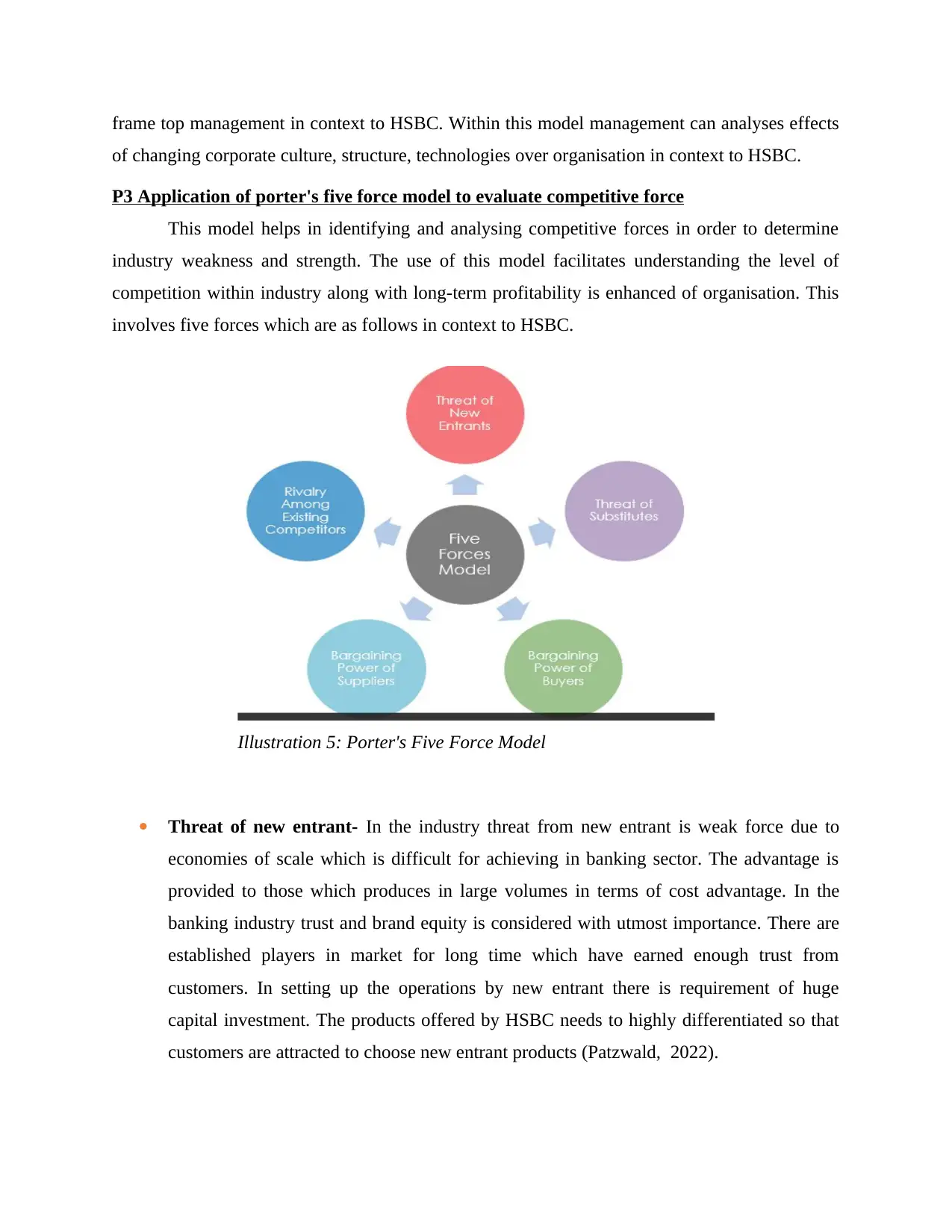
frame top management in context to HSBC. Within this model management can analyses effects
of changing corporate culture, structure, technologies over organisation in context to HSBC.
P3 Application of porter's five force model to evaluate competitive force
This model helps in identifying and analysing competitive forces in order to determine
industry weakness and strength. The use of this model facilitates understanding the level of
competition within industry along with long-term profitability is enhanced of organisation. This
involves five forces which are as follows in context to HSBC.
Threat of new entrant- In the industry threat from new entrant is weak force due to
economies of scale which is difficult for achieving in banking sector. The advantage is
provided to those which produces in large volumes in terms of cost advantage. In the
banking industry trust and brand equity is considered with utmost importance. There are
established players in market for long time which have earned enough trust from
customers. In setting up the operations by new entrant there is requirement of huge
capital investment. The products offered by HSBC needs to highly differentiated so that
customers are attracted to choose new entrant products (Patzwald, 2022).
Illustration 5: Porter's Five Force Model
of changing corporate culture, structure, technologies over organisation in context to HSBC.
P3 Application of porter's five force model to evaluate competitive force
This model helps in identifying and analysing competitive forces in order to determine
industry weakness and strength. The use of this model facilitates understanding the level of
competition within industry along with long-term profitability is enhanced of organisation. This
involves five forces which are as follows in context to HSBC.
Threat of new entrant- In the industry threat from new entrant is weak force due to
economies of scale which is difficult for achieving in banking sector. The advantage is
provided to those which produces in large volumes in terms of cost advantage. In the
banking industry trust and brand equity is considered with utmost importance. There are
established players in market for long time which have earned enough trust from
customers. In setting up the operations by new entrant there is requirement of huge
capital investment. The products offered by HSBC needs to highly differentiated so that
customers are attracted to choose new entrant products (Patzwald, 2022).
Illustration 5: Porter's Five Force Model
⊘ This is a preview!⊘
Do you want full access?
Subscribe today to unlock all pages.

Trusted by 1+ million students worldwide
1 out of 24
Related Documents
Your All-in-One AI-Powered Toolkit for Academic Success.
+13062052269
info@desklib.com
Available 24*7 on WhatsApp / Email
![[object Object]](/_next/static/media/star-bottom.7253800d.svg)
Unlock your academic potential
Copyright © 2020–2025 A2Z Services. All Rights Reserved. Developed and managed by ZUCOL.




